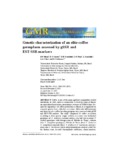Use este identificador para citar ou linkar para este item:
http://www.alice.cnptia.embrapa.br/alice/handle/doc/903366Registro completo de metadados
| Campo DC | Valor | Idioma |
|---|---|---|
| dc.contributor.author | MISSIO, R. F. | pt_BR |
| dc.contributor.author | CAIXETA, E. T. | pt_BR |
| dc.contributor.author | ZAMBOLIM, E. M. | pt_BR |
| dc.contributor.author | PENA, G. F. | pt_BR |
| dc.contributor.author | ZAMBOLIM, L. | pt_BR |
| dc.contributor.author | DIAS, L. A. S. | pt_BR |
| dc.contributor.author | SAKIYAMA, N. S. | pt_BR |
| dc.date.accessioned | 2011-10-18T11:11:11Z | pt_BR |
| dc.date.accessioned | 2011-10-18T11:11:11Z | pt_BR |
| dc.date.available | 2011-10-18T11:11:11Z | pt_BR |
| dc.date.available | 2011-10-18T11:11:11Z | pt_BR |
| dc.date.created | 2011-10-18 | pt_BR |
| dc.date.issued | 2011 | pt_BR |
| dc.identifier.citation | Genetics and Molecular Research, v. 10, n. 4, p 2366-2381, 2011. | pt_BR |
| dc.identifier.uri | http://www.alice.cnptia.embrapa.br/alice/handle/doc/903366 | pt_BR |
| dc.description | Coffee is one of the main agrifood commodities traded worldwide. In 2009, coffee accounted for 6.1% of the value of Brazilian agricultural production, generating a revenue of US$6 billion. Despite the importance of coffee production in Brazil, it is supported by a narrow genetic base, with few accessions. Molecular differentiation and diversity of a coffee breeding program were assessed with gSSR and EST-SSR markers. The study comprised 24 coffee accessions according to their genetic origin: arabica accessions (six traditional genotypes of C. arabica), resistant arabica (six leaf rust-resistant C. arabica genotypes with introgression of Híbrido de Timor), robusta (five C. canephora genotypes), Híbrido de Timor (three C. arabica x C. canephora), triploids (three C. arabica x C. racemosa), and racemosa (one C. racemosa). Allele and polymorphism analysis, AMOVA, the Student t-test, Jaccard?s dissimilarity coefficient, cluster analysis, correlation of genetic distances, and discriminant analysis, were performed. EST-SSR markers gave 25 exclusive alleles per genetic group, while gSSR showed 47, which will be useful for differentiating accessions and for fingerprinting varieties. The gSSR markers detected a higher percentage of polymorphism among (35% higher on average) and within (42.9% higher on average) the genetic groups, compared to EST-SSR markers. The highest percentage of polymorphism within the genetic groups was found with gSSR markers for robusta (89.2%) and for resistant arabica (39.5%). It was possible to differentiate all genotypes including the arabica-related accessions. Nevertheless, combined use of gSSR and EST-SSR markers is recommended for coffee molecular characterization, because EST-SSRs can provide complementary information. | pt_BR |
| dc.language.iso | eng | eng |
| dc.rights | openAccess | eng |
| dc.subject | Microsatellite marker | pt_BR |
| dc.subject | Genetic diversity | pt_BR |
| dc.title | Genetic characterization of an elite coffee germplasm assessed by gSSR and EST-SSR markers. | pt_BR |
| dc.type | Artigo de periódico | pt_BR |
| dc.date.updated | 2011-10-18T11:11:11Z | pt_BR |
| dc.subject.nalthesaurus | Coffea | pt_BR |
| dc.subject.nalthesaurus | Discriminant analysis | pt_BR |
| riaa.ainfo.id | 903366 | pt_BR |
| riaa.ainfo.lastupdate | 2011-10-18 | pt_BR |
| dc.contributor.institution | Universidade Federal do Paraná; EVELINE TEIXEIRA CAIXETA, SAPC; BioCafé; BioCafé; BioCafé; UFV; BioCafé/UFV. | pt_BR |
| Aparece nas coleções: | Artigo em anais de congresso (SAPC)  | |
Arquivos associados a este item:
| Arquivo | Descrição | Tamanho | Formato | |
|---|---|---|---|---|
| Geneticcharacterizationofanelitecoffee.pdf | 960.34 kB | Adobe PDF |  Visualizar/Abrir |









